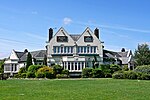The Bingley Arms
10th-century establishments in EnglandEnglish brandsGrade II listed pubs in LeedsUse British English from November 2021

The Bingley Arms is a public house in Bardsey, Leeds, West Yorkshire, England. It claims to be both the oldest surviving business and oldest surviving pub in the United Kingdom. It is possibly the fourth oldest surviving business in Europe.
Excerpt from the Wikipedia article The Bingley Arms (License: CC BY-SA 3.0, Authors, Images).The Bingley Arms
Church Lane, Leeds Bardsey cum Rigton
Geographical coordinates (GPS) Address Phone number Website External links Nearby Places Show on map
Geographical coordinates (GPS)
| Latitude | Longitude |
|---|---|
| N 53.8816 ° | E -1.4483 ° |
Address
Bingley Arms
Church Lane 37
LS17 9DR Leeds, Bardsey cum Rigton
England, United Kingdom
Open on Google Maps










